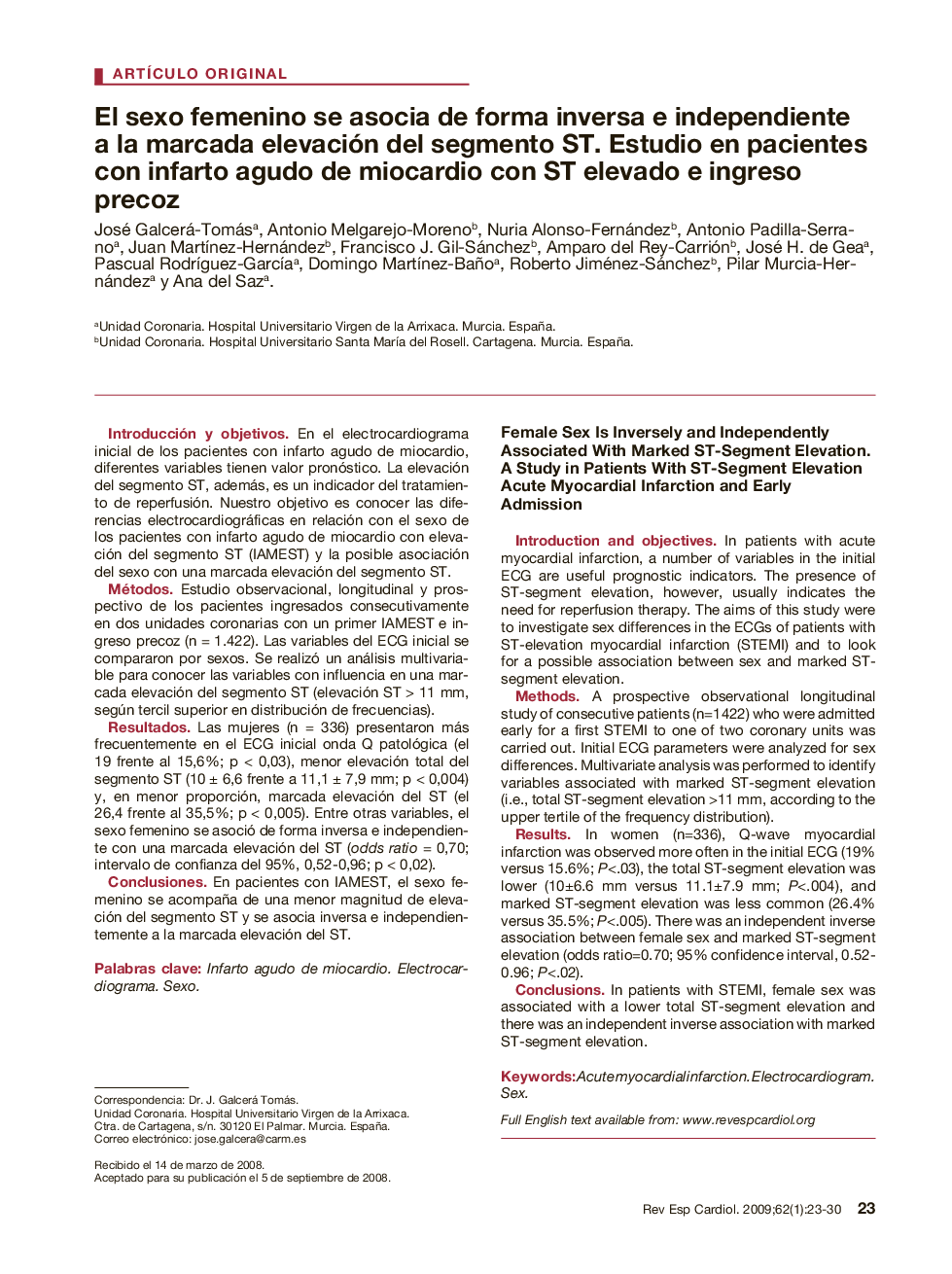| کد مقاله | کد نشریه | سال انتشار | مقاله انگلیسی | نسخه تمام متن |
|---|---|---|---|---|
| 3015334 | 1181953 | 2009 | 8 صفحه PDF | دانلود رایگان |

Introducción y objetivosEn el electrocardiograma inicial de los pacientes con infarto agudo de miocardio, diferentes variables tienen valor pronóstico. La elevación del segmento ST, además, es un indicador del tratamiento de reperfusión. Nuestro objetivo es conocer las diferencias electrocardiográficas en relación con el sexo de los pacientes con infarto agudo de miocardio con elevación del segmento ST (IAMEST) y la posible asociación del sexo con una marcada elevación del segmento ST.MétodosEstudio observacional, longitudinal y prospectivo de los pacientes ingresados consecutivamente en dos unidades coronarias con un primer IAMEST e ingreso precoz (n = 1.422). Las variables del ECG inicial se compararon por sexos. Se realizó un análisis multivariable para conocer las variables con influencia en una marcada elevación del segmento ST (elevación ST > 11 mm, según tercil superior en distribución de frecuencias).ResultadosLas mujeres (n = 336) presentaron más frecuentemente en el ECG inicial onda Q patológica (el 19 frente al 15,6%; p < 0,03), menor elevación total del segmento ST (10 ± 6,6 frente a 11,1 ± 7,9 mm; p < 0,004) y, en menor proporción, marcada elevación del ST (el 26,4 frente al 35,5%; p < 0,005). Entre otras variables, el sexo femenino se asoció de forma inversa e independiente con una marcada elevación del ST (odds ratio = 0,70; intervalo de confianza del 95%, 0,52-0,96; p < 0,02).ConclusionesEn pacientes con IAMEST, el sexo femenino se acompaña de una menor magnitud de elevación del segmento ST y se asocia inversa e independientemente a la marcada elevación del ST.
Introduction and objectivesIn patients with acute myocardial infarction, a number of variables in the initial ECG are useful prognostic indicators. The presence of ST-segment elevation, however, usually indicates the need for reperfusion therapy. The aims of this study were to investigate sex differences in the ECGs of patients with ST-elevation myocardial infarction (STEMI) and to look for a possible association between sex and marked ST-segment elevation.MethodsA prospective observational longitudinal study of consecutive patients (n=1422) who were admitted early for a first STEMI to one of two coronary units was carried out. Initial ECG parameters were analyzed for sex differences. Multivariate analysis was performed to identify variables associated with marked ST-segment elevation (i.e., total ST-segment elevation >11 mm, according to the upper tertile of the frequency distribution).ResultsIn women (n=336), Q-wave myocardial infarction was observed more often in the initial ECG (19% versus 15.6%; P<.03), the total ST-segment elevation was lower (10±6.6 mm versus 11.1±7.9 mm; P<.004), and marked ST-segment elevation was less common (26.4% versus 35.5%; P<.005). There was an independent inverse association between female sex and marked ST-segment elevation (odds ratio=0.70; 95% confidence interval, 0.52-0.96; P<.02).ConclusionsIn patients with STEMI, female sex was associated with a lower total ST-segment elevation and there was an independent inverse association with marked ST-segment elevation.
Journal: Revista Española de Cardiología - Volume 62, Issue 1, January 2009, Pages 23–30